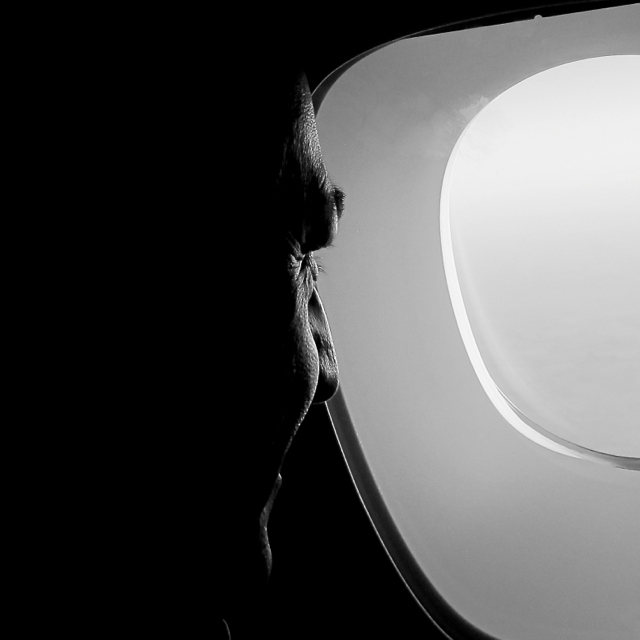LION AIR JT610
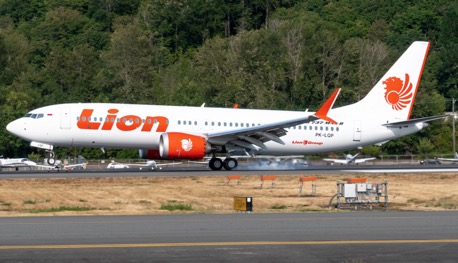
©CanAmJetz_Aug2018
This post is in chronological order, the latest post, 14 Jan 2018, is at the bottom.
737 CRASHED FROM 5,000 FEET AT 340 KTS
A LION AIR 737 crashed in to the sea after takeoff from Jakarta on Monday 20th October, after flying for 13 minutes.
After what appears as a normal departure, the aircraft turned-back over the airport, and headed-out over the coast.
In the last minute of flight, the recording on Flight Radar 24 (below) showed that the aircraft descended from 5,000 feet to 3,650 feet, while increasing speed from 334 knots to 345 knots.
The crew of a tug-boat leaving port saw the aircraft descending.
Debris, body parts, and life jackets have been recovered from the crash location which is 11 nautical miles from the coast. At the crash site the water is 30 metres deep. There are no survivors.
The ABC is reporting that the crew reported technical difficulties after takeoff. The Pilots told ATC that they would be returning to Jakarta.
The Height / Speed trace shows a worrying event, only one and a half minutes after takeoff. The aircraft was passing 2000 feet and doing 265 knots which may be considered normal. Then for 25 seconds the aircraft descended to 1,600 feet and increased speed to 334 knots. Half a minute later they appear to have recovered, climbed to 5,000 feet and reduced the speed to around 300 knots.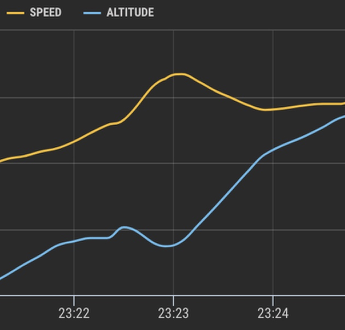
The lack of adherence to an altitude gives the impression that the autopilot was not connected. We will have to wait until the ATC releases more information about the "technical difficulties" reported by the pilots, and if they had requested vectors to an area to conduct trouble shooting.
The weather at the time (0630 local) was:
Wind - Southerly at 3 knots,
Visibility - 8 kms (usually haze),
Cloud - Scattered at 2,000 feet.
Temperature - 27 / Dew point 25.
Weather is ruled-out as a cause for this crash.
The previous day the aircraft flew from Bali, suffering an event which the Captain wrote-up in the Technical and Maintenance Log as:
"IAS and ALT DISAGREE SHOWN AFTER TAKEOFF"
(Airspeed and Altitude Disagreement)
Maintenance work was carried out: "Performed flushing of left hand pitot air data module and static air data module. Operational test on ground found satisfactory." and the fault was signed-off.
The aircraft also had its "Elevator Feel Computer electrical connection cleaned." A ground check was also carried-out.
It is my opinion that the pilots had an Unreliable Airspeed issue, and were overwhelmed by the procedure.
It appears, from the debris, that the aircraft disintegrated upon hitting the sea at high speed.
24 hours later, divers have found the tail section, despite the 'Black Box' pingers failing to operate.
_______________________________________
LION AIR 737-MAX 8 Rego PK-LQP
Lion Airlines Flight JT610 / LNI610
Jakarta (CGK) to Pangkal Pinang (PGK)
_______________________________________
ABC NEWS report: https://tinyurl.com/ydy2hl9s
30th Oct 2018
_______________________________________
SUBSEQUENTLY…
More information continues to come out about the Technical Log and the previous flight's issues. Also Flight Radar24 has released detailed height and speed traces from ADS-B stations.
The Tech Log is here with an interesting discussion about the various versions and the dangers of social media. Please read it.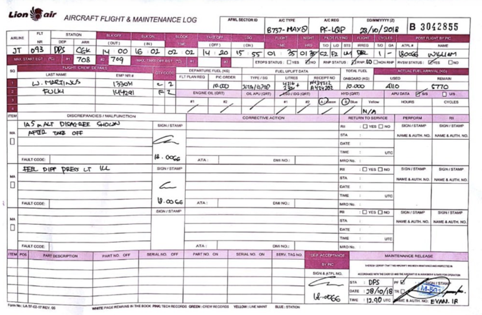
The Tech Log after the previous flight, before maintenance action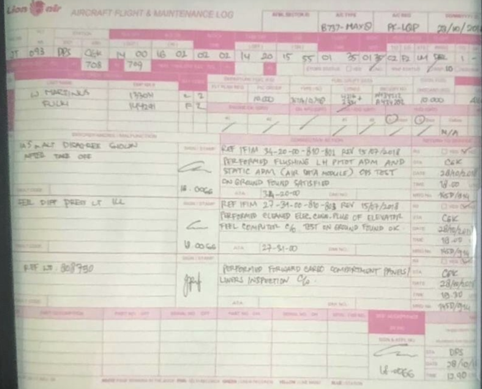
The Tech Log after the previous flight, after maintenance action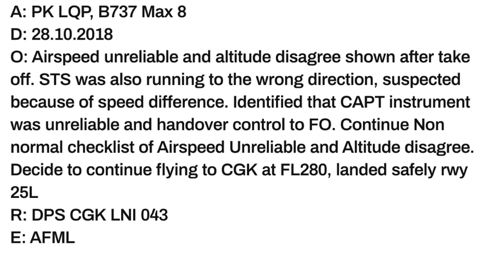
Narrative about the previous flight. (STS stands for Speed Trim System).
Flight Radar24 data shows ground speed (knots), altitude, track, and vertical speed (feet-per-minute).
In my opinion, there is no need to exceed 250 knots below 10,000 feet in normal operations around coastal airports, due to likelihood of sea birds. Previous studies by Airbus have shown that damage from birdstrikes increases markedly above 250 knots. So attention is drawn to every time JT610 exceeded 250 knots.
Also, close to the 'edges of the air' is no place for an aircraft in trouble; so I have highlighted all descents.
The last page, at the end of the flight, shows massive excursions. The Speed shown is ground-speed, not indicated airspeed. One may deduce that the aircraft wing stalled and the stall was not recovered. The Digital Flight Data Recorder DFDR, when recovered, will be able to determine if this was the case.
At 360 knots, with a rate of descent of over 30,000 feet-per-minute, the aircraft can be expected to disintegrate upon impact with the sea; as seen in the SwissAir 111 and Challenger Shuttle crashes.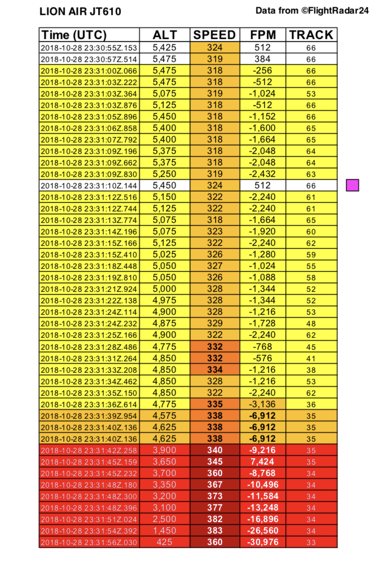
Extract from the ©FlightRadar24 data.
It is my opinion that training of the Unreliable Airspeed drill needs to be simplified.
Every pilot holds a number of licences, and any Examiner can examine ANY licences held. The basic Visual Flight Rules (restricted) Licence nominates four mandatory instruments for flight:
- Compass
- Airspeed
- Altimeter
- Clock
Luckily, for many airline pilots, they do not have to answer that question in the grilling session (interrogation) before heading into the simulator for their licence renewal. Many would fail. And a fail of a VFR licence question would also result in a fail of their Airline Transport Licence renewal.
Every pilot is expected to be able to perform basic visual flying. Look out the window and fly.
In good weather conditions, the Unreliable Airspeed case relies on a pilot to be able to fly manually whilst the co-pilot helps trouble shoot the situation.
Both Airbus and Boeing have set figures which pilots are expected to memorise, in order to fly away from the edges of the air.
Choose a pitch so the aircraft goes up. Look out the window, and use the standby artificial horizon (AH), or whichever pilots AH matches the view out the window.
Use a manual thrust setting that you'd normally use to go up.
This results in a speed. The airspeed indication may be giving false information and setting-off alarms. Killing the noise quickly by silencing the alarms is crucial. Unlike the movies, you want the cockpit to be very quiet, so you can think.
Make a MAYDAY call and get ATC to clear the airspace in front of you to 20,000 feet, and keep going up. You have time. This is not a high-speed emergency.
Eventually, when you have the charts out, and have discussed the next step, plan to fly level. This may be at 10,000 feet. If it's 15,000 feet, who cares?
Plan your descent.
The best way to descend is the way we do it every day, pick a pitch, say just below the horizon, and reduce thrust to zero.
Fly down to the platform altitude in the charts from above, and use the pitch and thrust settings in the chart. Those two give you the speeds you need to configure and land the aircraft.
Airbus have a nifty feature called the BUSS - Back Up Speed Scale. It makes flying this procedure simple, which is important because your stress levels are very high. Fly the GREEN and stay out of the RED.
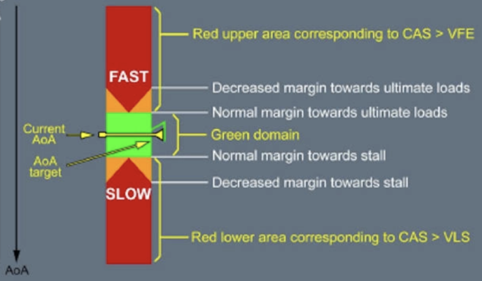
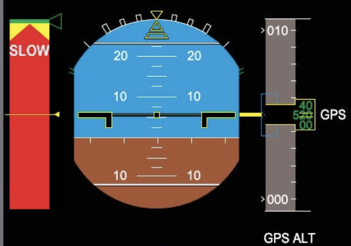
Good airlines get their pilots to practice this in the simulator on a regular basis.
Ken Pascoe , a Boeing 777 / 787 Type Rating Examiner, made this very interesting post on my Facebook feed. It is worth capturing:
"Not wishing to comment directly on this until we have better info - but genuinely unreliable airspeed once airborne - rather than racing down the runway with both pitot and/or static ports taped up from turn arounds or washing - can be an insidious non normal.
We hit crew with it regularly in the sim and even “experienced” crew can get themselves into trouble with it. There are lots of reason for this. One amongst them is the focus on some airline flight ops policies to minimise hand flying in the aircraft in favour of maintaining the highest levels of automation.
Boeing spent a great deal of time and effort a few years go researching and revising the associated checklist and it’s greatly improved.
But it’s still a no AP, no FD, no A/THR emergency that you’re thrown into just shortly after things were going swimmingly well.
Expeditious, accurate recognition is crucial. I watched a 787 crew deal with this a while ago and once recognised, PF reached over and switched across to AoA airspeed, NNM over.
That’s the future. Meanwhile the MAX - which could be everything the 787 is and in fact more - is held back by the requirement for commonality with the 737NG.
As mentioned - there are many factors (as there always are) in this - some on the surface, some very deep indeed."
DO YOURSELF A FAVOUR
Please follow the link HERE to see Ken Pascoe's excellent discussion of this emergency.
31st Oct 2018
_______________________________
F.A.A. ISSUES BOEING 737
AIRWORTHINESS DIRECTIVE
Download the full directive HERE
Flight International reports:
"The Federal Aviation Administration has issued an emergency order addressing the risk that faulty angle-of-attack inputs could cause Boeing 737 Max horizontal stabilisers to put the aircraft into a difficult-to-control dive.
"Possible erroneous angle-of-attack inputs on Boeing 737 Max aircraft… can potentially make the horizontal stabilizers repeatedly pitch the nose of the airplane downward, making the aircraft difficult to control," says the FAA in a 7 November emergency airworthiness directive.
Effective immediately, the FAA orders US operates to revise flight manuals "to give the flight crew horizontal stabiliser trim procedures to follow under certain conditions", the order says.
The FAA gives operators three days to make the updates."
©Flight International 2018 article HERE
The required attachments to the Airworthiness Directive are below:
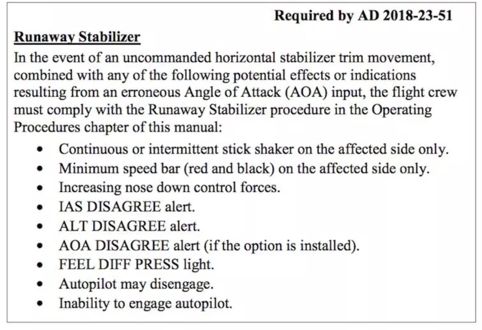
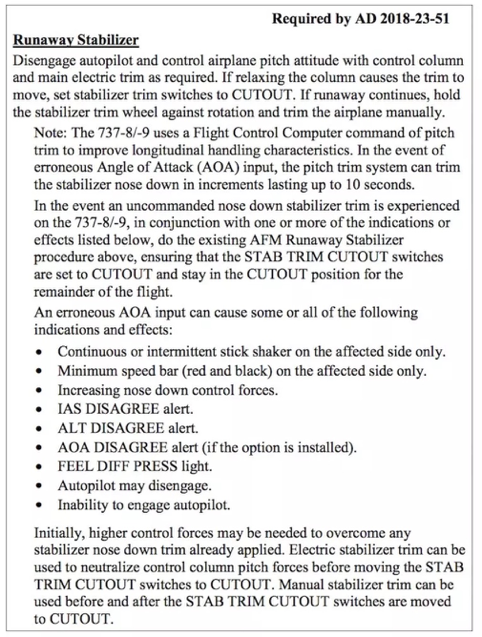
08 Nov 2018
_______________________________________
Investigator's DFDR Video
There are numerous fake videos surfacing which purport to replicate the Lion Air flight. This video came to me from a source close to the investigation, and was shot on a phone by someone in the team. I was asked not to show it publicly.
Since then it has begun appearing on Facebook. After checking with my source I now have permission to show it.
Still, I caution that we may be the victims of a cruel hoax.
Do Not Watch This if you a family member, are under 18 years old, or are not an aviation professional. This video is extremely distressing.
I show it as a cautionary warning to pilots. You must treat Unreliable Airspeed / Jammed Stabs as recall items. If you don't feel confident, ask your Fleet Manager for an extra sim session.
If you are refused extra training, please contact me.
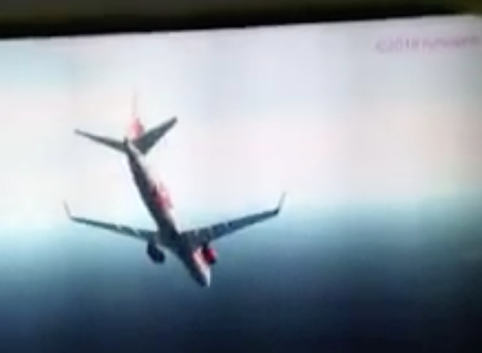
CAUTION Do you need to see this?
You can't UN-see this.
To see the video, click HERE
13 Nov 2018
_______________________________________
Pilots Not Told About 737 MAX
Auto Trim System

Avweb's Paul Bertorelli has provided new, shocking information:
"Boeing kept airlines and pilots in the dark about an automated background trim system on the 737 MAX that may be implicated in the first crash of the new model in Indonesia last month. The trim system, which is meant to improve pitch characteristics and stall protection, wasn’t even described in any of the documentation provided to pilots transitioning to the new aircraft."
As with ALL aircraft crashes, there is more to come out, so we must wait for the Investigators to do their job, and we think of the divers, crawling around in the metre-thick sludge trying desperately to locate the Voice Recorder that will hold many answers.
Meanwhile, I implore you to read Bertorelli's expose HERE
15 Nov 2018
_______________________________________
What Is The Boeing MCAS?
The Air Current's Jon Ostrower gives a great understanding of the Maneuvering Characteristics Augmentation System which Boeing added to the 737 MAX, without telling any of its pilots. Take five minutes to read it HERE.
17 Nov 2018
_______________________________________
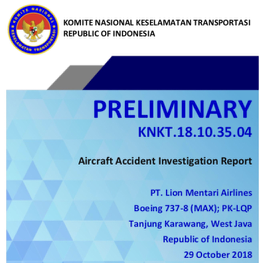
Preliminary Report
The Preliminary Aircraft Accident
Investigation Report is HERE.
29 Nov 2018
_______________________________________
Voice Recorder Found
The New York Times is reporting that the
Voice Recorder has been found. HERE
14 Jan 2019
____________________________________
